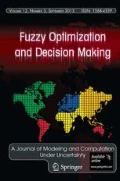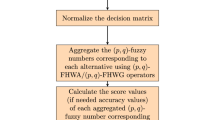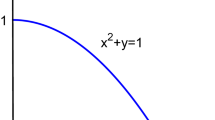Abstract
Weighted aggregation of fuzzy preference relations on the set of alternatives by several criteria in decision-making problems is considered. Pairwise comparisons with respect to importance of the criteria are given in fuzzy preference relation as well. The aggregation procedure uses the composition between each two relations of the alternatives. The membership function of the newly constructed fuzzy preference relation includes t-norms and t-conorms to take into account the relation between the criteria importance. Properties of the composition and new relation, giving a possibility to make a consistent choice or to rank the alternatives, are proved. An illustrative numerical study and comparative examples are presented.
Similar content being viewed by others
References
Alonso, S., Chiclana, F., Herrera, F., Herrera-Viedma, E., Alcala-Fdez, J., & Porcel, C. (2005). A consistency based procedure to estimate missing pairwise preference values. International Journal of Intelligent Systems, http://decsai.ugr.es/viedma/public.html.
Basile L. (1990) Ranking alternatives by weak transitivity relation. In: Kacprzyk J., Fedrizzi M. (eds). Multiperson decision making using fuzzy sets and possibility theory. Netherlands, Kluwer, pp. 105–112
Calvo T., Mesiar R. (2003). Aggregation operators: Ordering and bounds. Fuzzy Sets and Systems, 139, 685–697
Chiclana F., Herrera F., Herrera-Viedma E. (1998). Integrating three representation models in fuzzy multipurpose decision making based on fuzzy preference relations. Fuzzy Sets and Systems, 97, 33–48
Chiclana, F., Herrera, F., & Herrera-Viedma, E. (2000). The ordered weighted geometric operator: Properties and applications. In: Proc. of 7th IPMU’2000, Int. Conf. on Inf. Proc. and Manag. of Univ. in Knowledge-Bases Systems, IPMU’2000, vol. II, DECSAI University of Granada, 2000, pp. 985–991.
Chiclana F., Herrera F., Herrera-Viedma E. (2001). Integrating multiplicative preference relations in a multipurpose decision-making model based on fuzzy preference relations. Fuzzy Sets and Systems, 122, 277–291
Chiclana F., Herrera F., Herrera-Viedma E., Martinez L. (2003). A note on the reciprocity in the aggregation of fuzzy preference relations using OWA operators. Fuzzy Sets and Systems, 137, 71–83
Chiclana F., Herrera F., Herrera-Viedma E. (2004). Rationality of induced ordered weighted operators based on the reliability of the source of information in group decision–making. Kybernetika, 40, 121–142
Detyniecki, M. (2001). Mathematical aggregation operators and their application to video querying. Thesis for the degree Docteur de l’Universite Paris VI, www.lip6.fr/reports/lip6.2001.html.
Drewniak, J., & Dudziak, U. (2004). Safe transformations of fuzzy relations. In: Proceedings of EUROFUSE 2004, The 8-th Meeting of EURO Working Group on Fuzzy Sets, Workshop on Data and Knowledge Engineering, Sept. 22–25, 2004, Warszawa, Poland, pp. 195–203.
Dubois D., Prade H. (1980). Fuzzy sets and systems: Theory and applications. New York, Academic Press
Ekel P.Y. (2002). Fuzzy sets and models of decision making. International Journal of Computers and Mathematics with Applications, 44(7): 863–875
Fodor J.C., Roubens M. (1995). Characterization of weighted maximum and some related operations. Information Science, 84, 173–180
Grabisch M., Orlowski S., Yager R. (1998). Fuzzy aggregation of numerical preferences. In: Slowinski R. (eds). Fuzzy sets in decision analysis operations research and statistics, The handbooks of fuzzy sets series. Boston, Kluwer, pp. 31–68
Herrera-Viedma E., Herrera F., Chiclana F., Luque M. (2004). Some issues on consistency of fuzzy preference relations. European Journal of Operational Research, 154, 98–109
Jacas J., Recasens J. (2003). Aggregation of t-transitive relations. International Journal of Intelligent Systems, 18(12): 1193–1214
Jin, Y., & Sendhoff, B. (2002). Incorporation of fuzzy preferences into evolutionary multiobjective optimization. In: Proceedings of the 4-th Asia-Pacific Conference on Simulated Evolution and Learning, Singapore, Nov. 2002, pp. 26–30.
Kacprzyk J. (1986). Group decision making with a fuzzy linguistic majority. Fuzzy Sets and Systems, 18, 105–118
Ma J., Fan Z.P., Huang L.H. (1999). A subjective and objective integrated approach to determine attribute weights. European Journal of Operational Research, 112, 394–404
Ma J., Fan Z.P., Jiang Y.P., Mao J.Y., Ma L. (2006). A method for repairing the inconsistency of fuzzy preference relations. Fuzzy Sets and Systems, 157: 2033
Mesiar, R. (2003). Aggregation operators 2003. In: Proceedings of 3-rd Conference Of European Society for fuzzy Logic and Technology, EUSFLAT 2003, Sept. 10–12, Zittan, Germany, pp. 277–280.
Mesiar R., Saminger S. (2004). Domination of ordered weighted averaging operators over t-norms. Soft Computing, 8, 562–570
Nakamura K. (1986). Preference relations on a set of fuzzy utilities as a basis for decision making. Fuzzy Sets and Systems, 20, 147–162
Nguyen H.T., Walker E.A. (2000). Fuzzy logic. London, Chapman & Hall/CRC Press
Peneva V., Popchev I. (2003). Properties of the aggregation operators related with fuzzy relations. Fuzzy Sets and Systems, 139(3): 615–633
Peneva V., Popchev I. (2005). Weighted transformation in aggregation operators uniting fuzzy relations. Advanced Studies in Contemporary Mathematic, 10(1): 25–44
Roubens M. (1989). Some properties of choice functions based on valued binary relations. European Journal of Operation Research, 40, 309–321
Roubens, M. (1995). Fuzzy sets in preference modeling in decision analysis. In: Proceedings of VI IFSA World Congress, Sao Paulo, Brazil, 1995, pp. 19–23.
Sousa J., Kaymak U. (2001). Model of predicative control using fuzzy decision function. IEEE Transactions on SMC-Part B: Cybernetics, 31(1): 54–65
Tanino T. (1984). Fuzzy preference orderings in group decision making. Fuzzy Sets and Systems, 12, 117–131
Tanino T. (1988). Fuzzy preference relations in group decision making. In: Kacprzyk J., Roubens M. (eds). Non-conventional preference relations in decision making. Berlin, Springer-Verlag
Venugopalan P. (1992). Fuzzy ordered Sets. Fuzzy Sets and Systems, 46, 221–226
Xu Z.S. (2004a). Goal programming models for obtaining the priority vector of incomplete fuzzy preference relation. International Journal of Approximate Reasoning, 36(3): 261–270
Xu Z.S. (2004b). On compatibility of interval fuzzy preference matrices. Fuzzy Optimization and Decision Making, 3, 217–225
Xu Z.S. (2005). On method for uncertain multiple attribute decision making problems with uncertain multiplicative preference information on alternatives. Fuzzy Optimization and Decision Making, 4, 131–139
Xu Z., Da Q. (2003). An approach to improving consistency of fuzzy preference matrix. Fuzzy Optimization and Decision Making, 2, 3–12
Yager R.R. (1978). Fuzzy decision making including unequal objectives. Fuzzy Sets and Systems, 1, 87–95
Yager R.R. (1994). On weighted median aggregation. International Journal of Uncertainty, Fuzziness and Knowledge-based Systems, 2(1): 101–114
Yager R.R. (1996). On mean type aggregation. IEEE Transactions on SMC. Part B 26(2): 209–221
Zadeh L.A. (1971). A similarity relations and fuzzy orderings. Infomation Science, 3, 177–200
Zimmermann H.-J. (1993). Fuzzy set theory and its applications. Kluwer Academic Publishers: Noewell, MA
Author information
Authors and Affiliations
Corresponding author
Rights and permissions
About this article
Cite this article
Peneva, V., Popchev, I. Aggregation of fuzzy preference relations to multicriteria decision making. Fuzzy Optim Decis Making 6, 351–365 (2007). https://doi.org/10.1007/s10700-007-9018-6
Published:
Issue Date:
DOI: https://doi.org/10.1007/s10700-007-9018-6




